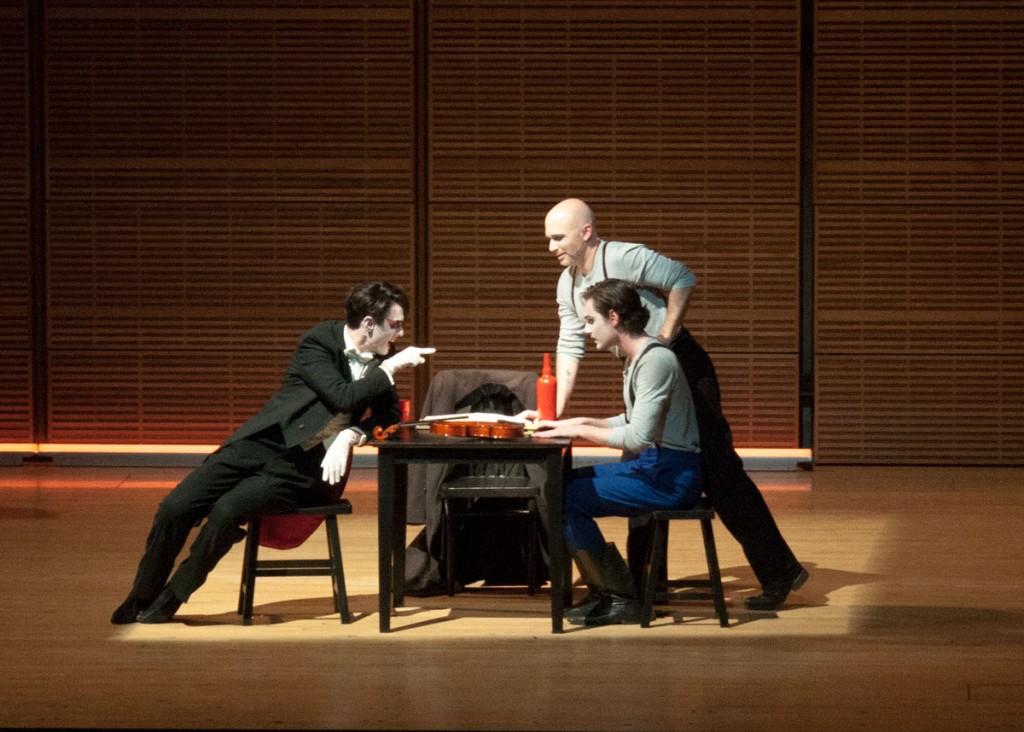Devil and Man at Yale—Stravinsky’s “Soldier’s Tale” soars at Zankel

Yale in New York presented Stravinsky’s “A Soldier’s Tale” Sunday at Zankel Hall. Photo: Dana Astmann.
The only thing wrong with Yale In New York’s staging of The Soldier’s Tale is that the performance seen in Zankel Hall Sunday night might be the last. This production is so smart, so dramatically and musically accomplished, and so true to the intent of Stravinsky and librettist C.F. Ramuz, that its biting tragedy is made more piquant by the thought that no one else might be able to witness it.
Perhaps someone with deep pockets will step forward and keep this show on the road, as the Swiss philanthropist Werner Reinhart did to support the premiere of this work in 1918. The Soldier’s Tale exists because Stravinsky, essentially exiled in Switzerland during World War I and cut off from his banks, needed to make money. So he and Ramuz created a compact and low-overhead entertainment about a Soldier with a violin who meets the Devil.
The piece is for a septet of musicians, three actors, and one—or more—dancers, and there is no requirement for sets and no particular need for costumes. A mix of folk-tales and fantasies, the piece can be made to work on stage with as little as one talented, charismatic performer.
This production, organized by Yale In New York’s musical director David Shifrin, directed by Liz Diamond, and co-produced by the university’s Schools of Drama and Music, has the full (minimal) complement, with veteran stage and screen actor (and Yale alum) Michael Cerveris as the Reader and MFA students Tom Pecinka, James Cusati-Moyer and Mariko Parker as the Soldier, the Devil and the Princess. There are graduate students in the septet too: Samuel Suggs on double bass, Michael Zuber playing bassoon Mikio Sasaki on trumpet, Stephen Ivany on trombone and percussionist Georgi Videnov.
There are two ringers too—Shifrin on clarinet and Ani Kavafian on violin (both are part of the Yale faculty). Though The Soldier’s Tale is a graduate school staple, a challenging and rewarding piece for both instrumentalists and conductors, this is not a student-level production. This staging has no conductor, and the polish and ease of the playing was deeply impressive.
The score is a transitional one for Stravinsky, and balances neo-Classical asceticism with constantly shifting time signatures out of his earlier ballets. Stravinsky establishes phrases and rhythms, and then presses and stretches them like a squeezebox. Keeping any group together is no simple task, yet without a conductor, the musicians literally did not miss a beat. More, they played beautifully, with excellent balances, ideal tempos, great swing from Suggs and Videnov, and a graceful trumpet solo from Sasaki in the serio-comic “Royal March.”
A genius like Stravinsky was able to take on practical problems and produce music with the highest level of craft, intelligence and creative brilliance. The music is consistently inspired but heard by itself, comes off as a set of fantastically made etudes. When the drama is realized, then the score accompanies, expresses and responds to the characters and the story; it takes on complex expressive power.
One case in point: the melancholy “Pastorale” in the second scene, when the Soldier returns home and realizes his three days spent drinking and dining with the Devil have been three years on earth, and his mother and fiancé see him as a terrifying ghost, risen from the dead. There was a palpable feeling of loss.
And the witty and inventive dance music for the Soldier and the Princess, a medley of tango, waltz and ragtime, makes more sense and is more affecting when there is actual dancing. Of the stage performers, only Parker is the dancer, but the choreography by Emily Coates is so earthy and well-crafted that Pecinka and Cusati-Moyer appear as naturals in the balletic, modern and popular phrases. Diamond’s direction has them in almost constant, dynamic movement, both around the stage and in a dramatic pas-de-deux.
They are exuberant, charismatic and confident performers, Cusati-Moyer perhaps just lipping the brim of camp before backing off. They don’t have Cerveris’ easy gravity, but then they lack his considerable experience. Still, Cusati-Moyer ad-libbed brilliantly when he accidentally knocked over a cup during the line “Whatever you want, but don’t be careless,” and Pecinka played along perfectly, leaving Cerveris struggling to control his own laughter.
Diamond wrote a new translation of the libretto, one that alters a few details—a carriage becomes a car—and lightly salts the text with contemporary American vernacular. The effect is to add a subtle sense of naturalism to all the line readings.
The Soldier is the center of the story, which ends with essentially a reversal of the Orpheus myth, but the Devil is the star, and some combination of Stravinsky’s difficult circumstances and his inherent impishness shapes the music in a spiky, unsettled direction. The Devil not only wins the Soldier’s soul in the end, but takes a victory march as a finale. Goodman and Coates push this even further, and the Devil dances and leaps about the stage in gripping, mean-spirited exuberance as the drums pound out the final rhythms.
A mutual triumph for the Devil and for Yale In New York






